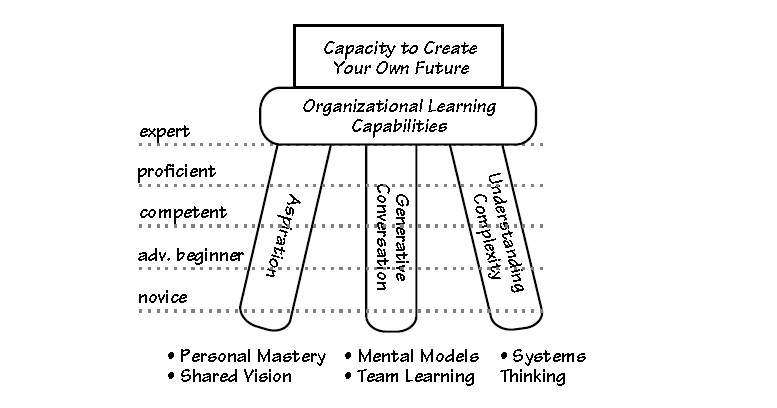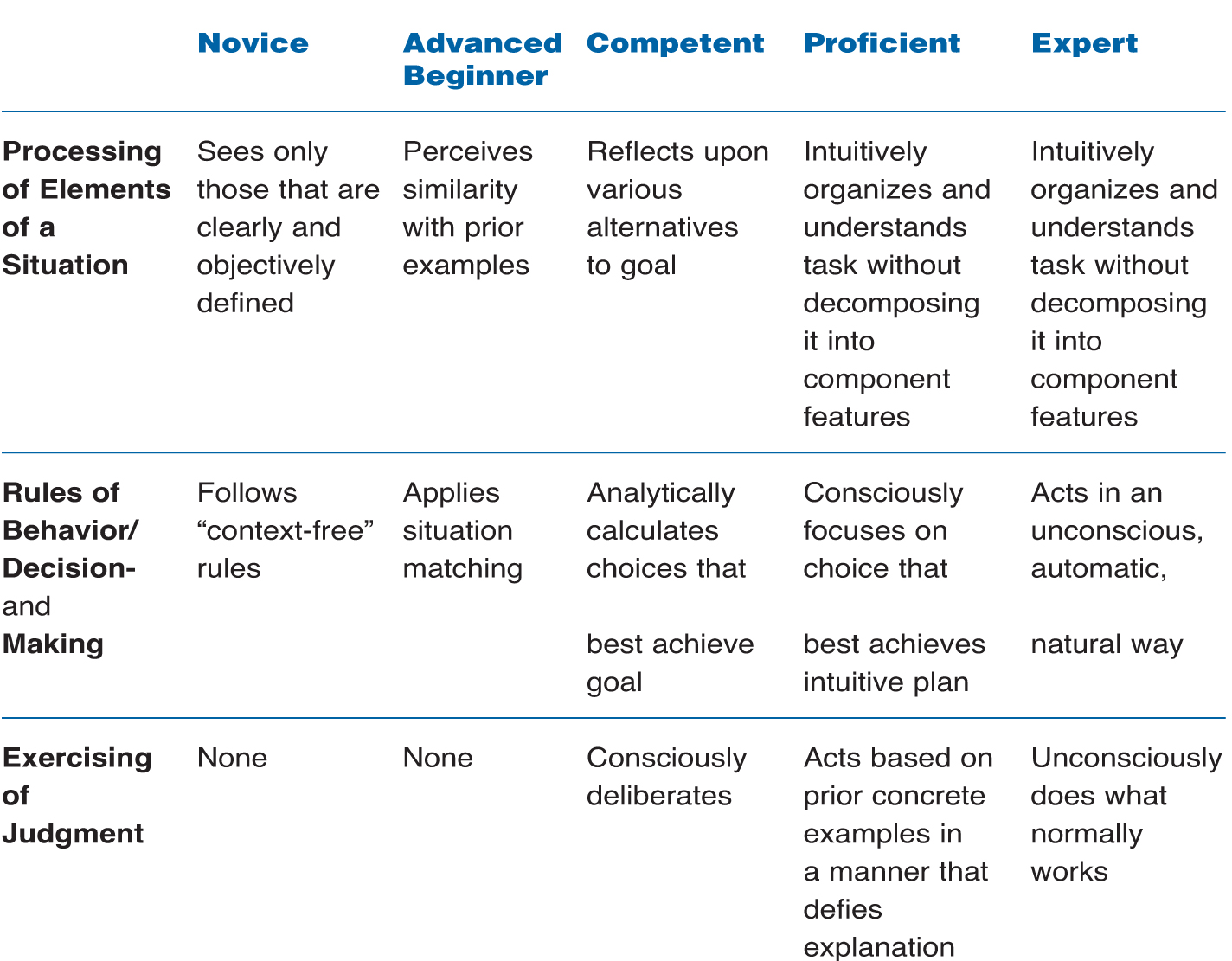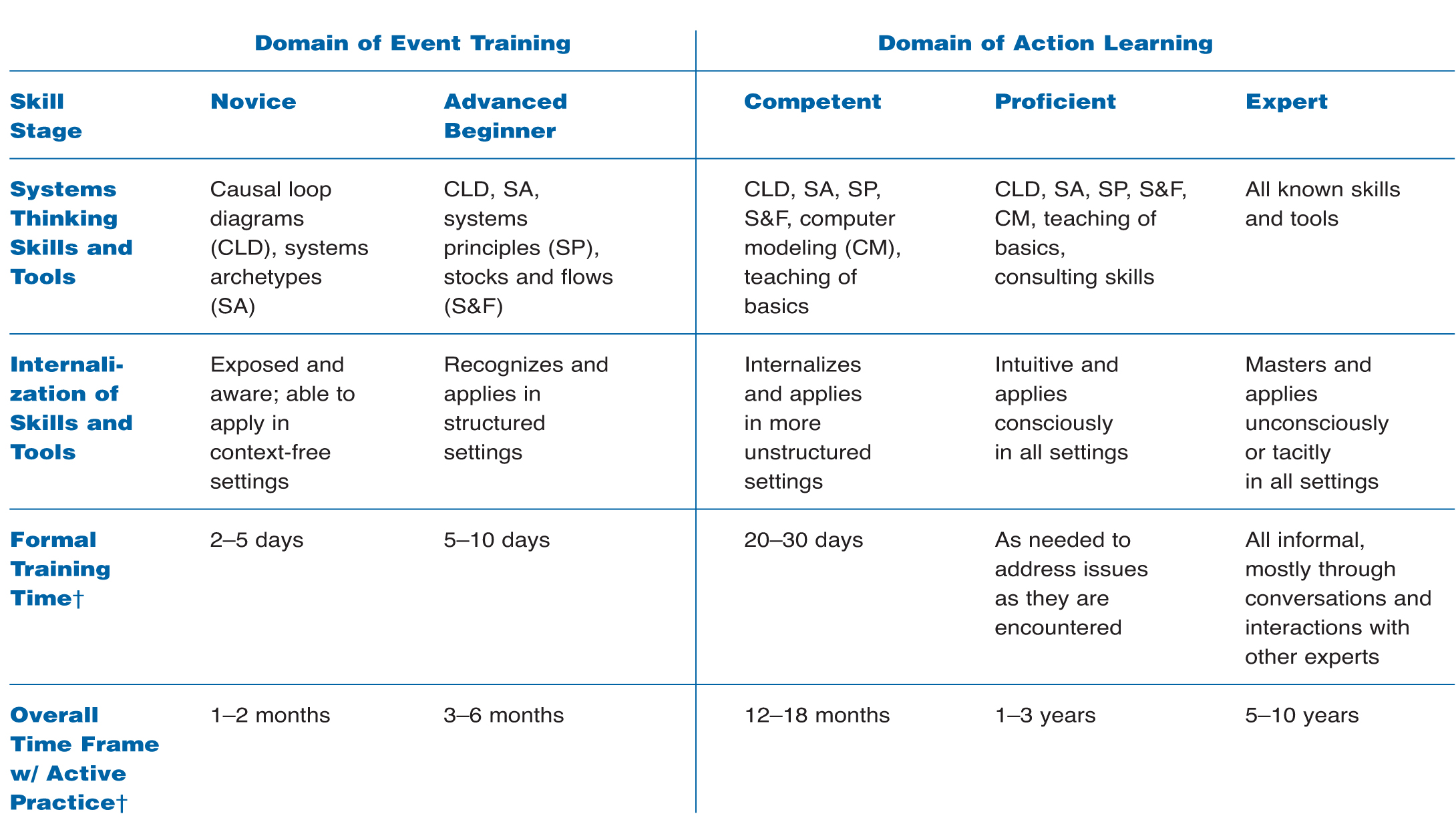If calculus were invented today, our organizations would not be able to learn it. We’d send everyone off to a three-day intensive program. We’d then tell everyone to try to apply what they’d learned. After three to six months we’d assess whether it was working. We’d undoubtedly then conclude that this ‘calculus stuff’ wasn’t all it was made out to be and go off and look for something else to improve results.” (Peter Senge, et al., The Fifth Discipline Fieldbook).
As the quote above illustrates, in today’s fast-paced business world, we seldom have the appropriate time perspective when investing in the acquisition of new skills. We tend to want things to be available in bite-sized chunks that we can conveniently fit into our busy schedules, and we want to see immediate results from those investments. Sending people to short skill-building workshops may be adequate for adding to a base of knowledge they already possess, such as training on a new machine or with a new accounting software package. If, on the other hand, we are interested in developing capabilities that are quite different from our current base of experience and skill, this approach is likely to produce disappointing results.
THREE-LEGGED STOOL

The stool represents the interdependence of three core capabilities to support organizational learning: Aspiration, Generative Conversation, and Understanding Complexity. Together, these three capabilities allow us to create our future.
Developing Organizational Learning Capabilities
For many organizations, developing the capabilities to support organizational learning requires the acquisition of markedly different skills from those they are currently using. In the absence of a solid understanding of what it really takes to develop such skills, many organizations fall into the trap described in the opening quote and abandon their efforts prematurely. The challenge multiplies when the skills involved function as an ensemble whose interdependent development is more important than the development of each one separately.
In The Fifth Discipline, Peter Senge defines learning organizations as those that continually enhance their capacity to create the results they truly care about. In our work at the Society for Organizational Learning (formerly the MIT Organizational Learning Center), we often talk about investing in three core capabilities to support organizational learning. We use the analogy of a three-legged stool to represent the interdependence of those three capabilities (see “Three-Legged Stool”).
The Aspiration leg of the stool focuses on developing a clear sense of purpose and vision both at an individual and at the larger organizational levels (disciplines of Personal Mastery and Shared Vision). The Generative Conversation leg centers on expanding our capacity to be more reflective in our thinking and to become more generative when we think and talk with others (disciplines of Mental Models and Team Learning). Understanding Complexity emphasizes internalizing perspectives and skills, which allows us to better understand and manage systemic interconnections that produce complex organizational dynamics (discipline of Systems Thinking). Together, these three capabilities allow us to create our future. They enable us to articulate clear visions of what results we want; they give us the capacity to have productive conversations about how to make those results happen; and they provide us with the conceptual tools and thinking to manage the complexities involved.
The image of the stool conveys a couple of important points. First, the stool must have all three legs to be stable enough to support anything, especially the capacity to create your own future. Second, if you do not develop these capabilities more or less together as an ensemble, the stool will have legs of different lengths and will be too wobbly to support anything for very long. So, even though you might experience momentary success in creating your own future, it will be short-lived if you do not balance the development of the three core capabilities.
A relevant question at this point might be, “How do we know the length of each leg at any point in time?” In other words, what kind of a common measurement can we use to gauge how we are doing over time, across a diverse set of capabilities? To answer these questions, we need a framework for talking together about what it means to develop each of these capabilities.
A Five-Stage Model of Skill Acquisition
Dreyfus and Dreyfus, in their book Mind Over Machines, offer a five-stage model of skill acquisition that provides a useful starting point in answering the questions posed above. They start by making a distinction between “knowing that” (knowing that certain rules and principles apply in a given situation) versus “knowing how” (being able to actually use the particular skill). These two kinds of knowledge are not equal, and having one doesn’t necessarily mean you have the other.
For example, although you obviously possess an expert’s know-how about walking, you probably can’t translate that capability into rules and procedures that would allow someone else to replicate the skill. In other words, you possess the “know-how” for walking but you don’t necessarily “know that” certain principles and movements allow you to produce that action; you just do it. In other situations where you might be a novice, like downhill skiing, you may clearly understand that you are supposed to keep your skis parallel, lean forward, and allow your legs to work like shock absorbers, but you may not be able to convert that knowledge into know-how that lets you ski gracefully down the slopes. As you struggle to keep your skis from crossing and end up tumbling down the slope, you are demonstrating the gap between “knowing that” and “knowing how.”
Based on extensive studies, Dreyfus and Dreyfus conclude that people generally go through five distinct stages from rule-guided “knowing that” to experienced-based “knowing how.” These stages are: Novice, Advanced Beginner, Competent, Proficient, and Expert. Each stage reflects different levels of competence in a number of specific capabilities, such as overall perception of a task situation and ability to exercise judgment (see “Five Stages of Skill Acquisition” on p. 3).
Novice. At this stage, learners have a beginning awareness of the existence of a particular subject area, but only at the level of abstract concepts and ideas. The instructor must clearly and objectively define elements of the situation to be treated so the novice can recognize them without reference to the overall situation in which they occur. Novices possess little or no ability to put ideas into practice in a reliable way. They apply their nascent skills by following a set of rules without regard for the context in which they are operating.
Advanced Beginner. Performance improves to a marginally acceptable level only after novices have considerable experience coping in real settings. Through repeated exposure to many situations, advanced beginners gain a deeper appreciation of the subject area and acknowledge their own lack of knowledge about the discipline as a whole. At the same time, they learn to apply principles and tools in contexts that are similar to well-defined cases they have studied. That is, advanced beginners can reliably follow the prescribed steps of a process, provided the situation closely matches ones they have previously encountered.
Competent. Achieving competence means having had exposure to, and a working familiarity with, the full array of knowledge that comprises the particular subject. At this stage, learners have received all the “knowing that” there is to know—additional instructions and tips will not make them any more competent. They have begun to internalize the new skills and capabilities by developing the ability to go beyond simply applying rule-bound procedures in highly structured settings. Competent individuals apply tools and principles in a broad range of circumstances, adapting their practices to the specific situation through careful study of the context and selection among viable alternatives.
Proficient. Proficiency comes neither from more book learning nor from instructional sessions but from direct experience gained by continual practice in diverse settings. Proficient performers have internalized all the tools and concepts of the field and can reliably apply the tools and principles to any task or situation in a highly flexible and fluid manner. They intuitively grasp the whole of a situation without decomposing it into component features (through a process known as “holistic discrimination and association”) and apply the appropriate set of skills. However, they still act based on a conscious decision-making process.
Expert. Experts generally know what to do based on mature and practiced understanding. They have fully internalized perception and action in their specific domain and do both intuitively, without conscious thought. An expert skier, for example, doesn’t consciously study the terrain and strategize about the best path to follow or form to use—she just skis down the hill, making adjustments as needed. When things are proceeding normally, experts don’t solve problems or make decisions; they just do what usually works. Experts often develop through mentoring relationships and apprenticeships, where they learn by absorbing new capabilities through continued exposure, observation, and interaction with an expert. Learning at this stage is often rooted in conversations and direct interaction with other experts. Doctoral programs for researchers and internships and residencies for medical doctors are examples of such institutionalized apprenticeships.
Five-Stage View of Systems Thinking
We can start to answer the questions we asked at the outset by walking through the five stages in the context of the core capabilities we saw in the three-legged stool diagram. In particular, we’ll apply the model to the discipline of Systems Thinking to get a sense of the kinds of progressive steps an individual would need to take on the road to becoming an expert systems thinker.
Novice Systems Thinkers have a basic literacy in the tool of causal loop diagrams (CLDs). They know the rules for assigning either an “s” (causing a change in the same direction) or an “o” (causing a change in the opposite direction) to each link and can tell the difference between reinforcing and balancing loops. They can read simple diagrams created by others, but cannot yet construct a diagram on their own. Novice systems thinkers also know about systems archetypes and can describe what each archetype structure looks like as well as its corresponding pattern of behavior over time.
Advanced Beginner Systems Thinkers have mastered the basic mechanics of using links (s’s and o’s) and loops (reinforcing and balancing) and can map out simple loop structures. They use the systems archetypes as “templates” to recognize similar structures and dynamics playing out in their own settings. Advanced beginners also understand the basic lessons of systems principles (generalized observations about how complex systems behave, such as worse before better, unintended sideeffects, and policy resistance). In addition, they can identify cases where systems principles prevail and anticipate when a systems principle applies to a specific situation. They are familiar with some basic stock and flow structures, such as the aging chain, co-flows, and anchoring-andadjustment, and can identify similar structures in their own settings.
FIVE STAGES OF SKILL ACQUISITION

Competent Systems Thinkers have mastered the art of developing CLDs on topics they are familiar with and can map as many loops as necessary. They have fully internalized the systems archetypes and use them to understand complex dynamics in diverse settings. They also intuit when systems principles are relevant to a situation and think through the process of identifying the structures that are operating. Competent systems thinkers represent structures equally well in both CLDs and stocks and flows. They can convert those pen-andpaper conceptual models into computer simulation models and possess a solid working knowledge of basic computer modeling tools and skills. Because they themselves are so consciously aware of the tools and skills they are learning, individuals at the competent stage are also capable of teaching others how to draw CLDs, use systems archetypes, identify systems principles, and develop basic stock and flow structures to the level of an advanced beginner.
Proficient Systems Thinkers view the world in terms of feedback loop structures and archetypal patterns. When they see profits falling, for example, they can’t help but look at the situation in a larger context of other critical variables that affect profits. When they encounter a problem, they immediately sense the systemic implications and explore possible actions using mapping and computer tools to help sort through the multiple possibilities. In addition to mastering all the skills found at the competent level, proficient systems thinkers can consult to others and tackle issues in any setting. They intuitively grasp the important systemic structures in a situation and then select the appropriate actions to take. Being a highly seasoned and capable systems thinking consultant means one has reached at least the proficient stage.
Expert Systems Thinkers have elevated all the skills and knowledge from the previous stages to the intuitive level. They use systems thinking as a natural part of the creative process; the concepts and tools are an inseparable part of how they think and act. Experts do not consciously use a systems thinking tool or try to think in a particularly systemic way; they simply do what normally works, which happens to be systemic in its approach.
The table called “Five-Stage View of Becoming a Systems Thinker” contains a summary of the stages for developing systems thinking skills and estimates of how much training and practice time are required to advance from stage to stage. The Novice and Advanced Beginner levels are based on the content delivered in most two- to five-day workshops currently offered by various organizations. The Proficient and Expert stages fall into the range of time required to earn a doctorate in the field of system dynamics. What is noteworthy about these time estimates is that there are virtually no public programs yet available to systematically elevate a person to the Competent stage. Hence there is no reliable way to build a level of competence within organizations, short of sending someone to a master’s or PhD program.
FIVE - STAGE VIEW OF BECOMING A SYSTEMS THINKER

The times are specific to each stage and are in addition to the times indicated in the previous stages. Also, the time frames shown are estimates that are meant to provide an order of magnitude reading rather than precise numbers for planning purposes. Many factors make the time frames longer or shorter for any specific individual.
The Case for Building Competence
The situation of developing organizational learning capabilities in most organizations is represented in “Outside Expertise vs. Internal Capability” by the two solid arrows at the top of the diagram. That is, companies invest in developing skills by using outside outside expertise to get people to a Novice or maybe an Advanced Beginner level. When those novices and advanced beginners fail to produce significant results through application of their new skills, many companies abandon the effort. But, if we hope to gain from the benefits of acquiring new organizational learning skills as an organization, we must be able to get a critical mass of people to at least the Competent level.
We are right back to the dilemma of learning calculus posed at the beginning of this article. Many organizations, for example, have dabbled in acquiring systems thinking skills and have sent people off to attend two- to five-day workshops. Most of these learners reach only a Novice level of capability, which does not produce many visible results. Sending them to additional workshops that are not coherently designed to build competence usually doesn’t do much to develop their capabilities beyond an Advanced Beginner level. And, without a framework for assessing what level of skill a learner has reached, managers may think that they have invested more than enough resources in developing knowledge of the discipline and conclude that something is wrong with the discipline itself.
The challenge for many organizations is sustaining a level of commitment over time to developing a certain level of internal capability and skill. One way of achieving this goal is to be more strategic in the use of outside expertise to help build internal competence in a systematic and measurable way (dotted arrow in “Outside Expertise vs. Internal Capability”). Once a core group of people has reached the Competent level, they can then apply what they know to produce better results for the organization and contribute toward developing others’ capabilities. This way of internalizing and leveraging knowledge thereby creates an internally driven self-reinforcing engine of growth (the lower arrows in the diagram).
If an organization is serious about developing its ability to create its own future, it must find a way to help a critical mass of employees reach the Competent level in a skill or set of skills. Gaining awareness of the different levels of skill development, consciously formulating a plan to develop internal competence, and leveraging the talents of outside trainers are key ways for organizations to start developing the pillars of organizational learning capabilities on which they can create their futures.
OUTSIDE EXPERTISE VS. INTERNAL CAPABILITY

The solid arrows at the top show that companies invest in outside expertise to get people to a Novice or Advanced Beginner level. The challenge is using outside expertise to help people reach the Competent level (dotted arrow). They can then contribute toward developingothersʼ capabilities (lower arrows).
Daniel H. Kim, PhD, is publisher of The Systems Thinker and a trustee on the governing council of the Society for Organizational Learning. He is a well-regarded author as well as an international public speaker, facilitator, and teacher of systems thinking and organizational learning.
Editorial support for this article was provided by Janice Molloy.
